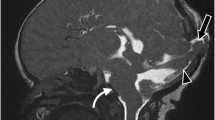Abstract
A case of monochorionic/monoamnionic twin with discordant occipital developmental malformations is presented. One female twin appeared to have an occipital meningocele with cerebellar aplasia and died immediately after birth. The other twin presented with signs and symptoms of raised intracranial pressure at the age of 7 months. Severe hydrocephalus was present due to an infected intracerebellar dermoid tumor with a contiguous occipital dermal sinus. The clinical and pathological characteristics are described and the different theories concerning twinning, embryogenesis, and dysmorphology in relation to neural tube defects are discussed. Analysis of the features of these monozygotic twins indicates that a meningocele is not a post-neurulation disorder but results from deficient neurulation, probably due to mesodermal insufficiency.
Similar content being viewed by others
References
Altman NR, Naidich TP, Braffman BH (1992) Posterior fossa malformations. AJNR 13:691–724
Campbell RL, Layton DH, Sohall GS (1986) Neural tube defects: a review of human and animal studies on the etiology of neural tube defects. Teratology 34:171–187
Correy JF, Newman NM, Collins JA, Burrows EA, Curran JT (1991) Use of prescription drugs in the first trimester and congenital malformations. Aust N Z J Obstet Gynaecol 31:340–344
Fisher NL, Smith DW (1981) Occipital encephalocele and early gestational hyperthermia. Pediatrics 68:480–483
French BN (1990) Midline fusion defects and defects of formation. In: Youmans JR (ed) Neurological surgery, vol 2. Saunders, Philadelphia, pp 1150–1164
Hay S, Wehrung DA (1970) Congenital malformations in twins. Am J Hum Genet 22:662–678
James WH (1976) Twinning and anencephaly. Ann Hum Biol 3:401–409
Lemire RJ (1982) Neural tube defects: clinical correlations. In: Proceedings of the Congress of Neurological Surgeons, Toronto, Canada. Williams & Wilkins, Baltimore, pp 165–177
Marin-Padilla M (1979) Notochordal-basichondrocranium relationships: abnormalities in experimental axial skeletal (dysraphic) disorders. J Embryol Exp Morphol 53:15–38
Marin-Padilla M (1980) Morphogenesis of experimental encephalocele (cranioschisis occulta). J Neurol Sci 46:83–99
Myrianthopoulos NC (1978) Congenital malformations: the contribution of twin studies. Birth Defects 14: 151–165
Rothman KJ (1977) Fetal loss, twinning and birth weight after oral-contraceptive use. N Engl J Med 297: 468–471
Schinzel AAGL, Smith DW, Miller JR (1979) Monozygotic twinning and structural defects. J Pediatr 95: 921–930
Windham GC, Sever LS (1982) Neural tube defects among twin births. Am J Hum Genet 34:988–998
Author information
Authors and Affiliations
Rights and permissions
About this article
Cite this article
Groen, R.J.M., van Ouwerkerk, W.J.R. Cerebellar dermoid tumor and occipital meningocele in a monozygotic twin: clues to the embryogenesis of craniospinal dysraphism. Child's Nerv Syst 11, 414–417 (1995). https://doi.org/10.1007/BF00717408
Received:
Issue Date:
DOI: https://doi.org/10.1007/BF00717408




